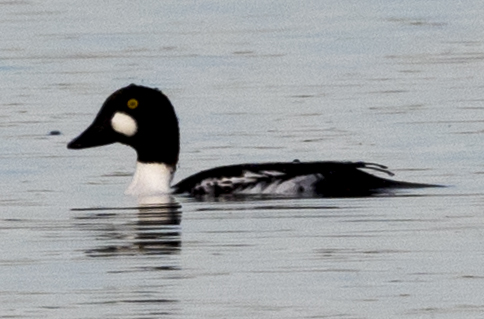I was so lucky to catch a couple of Bewick's Swans at Cliffe Pools. I saw them on the far side of Ski Pool when I arrived at the Radar Pool main viewpoint at about 3.45, but they had vanished by about 4 p.m. Using the highest magnification of the telescope I saw the yellow on the bill, but I thought clearly not enough yellow to be Whooper Swans - and the birds did look a little small!
A Barn Owl was hunting, and went down by one of the hedges, again at about 4.
There were also large numbers of Great Crested and Little Grebes, as well as Wigeon, Teal, Tufted Duck, Pochard and Mallard on Radar, with a few Gadwall, and then more Shoveller on Flamingo.
Bewick's Swan (named after the engraver Thomas Bewick) is still thought to be a subspecies, currently known as Cygnus columbianus bewickii of the Tundra Swan, Cygnus columbianus. There apears to be a typical cline within this species, largely of size and bill colouring - the type tends to be larger, with nearly entirely blackish bills, broken partly across the Bering Straits, separating the two subspecies. However some people have separated Bewick's off into a new species, Cygnus bewickii. The North American type, Cygnus columbianus columbianus, also used to be known as the whistling swan, of which there may be a little over 200,000 birds in total, and there have been a couple of suspected vagrants of this type subspecies recorded for the UK.
Bewick's Swan nests on the High Arctic tundra of Russia, from the Kanin peninsula all the way across to Kolyuchinskaya Bay, and winters in two main groups, the smaller one of about 20,000 birds in North-Western Europe (amber listed at European level) including 7,000 or so in the UK (decreasing slowly, and again amber listed), and the other larger group of about 100,000 birds in the Far East, mainly in China.
These eastern birds are larger than the European Bewick's and with less yellow on the bills but smaller than the American type birds and more yellow on the bills than them. There is a third very much smaller migration group that winters "in the middle" around the Black, Caspian and Aral Seas, but of only about 1,000 birds. Bewicks generally arrive on the breeding grounds in about May, laying eggs between mid-May and early July. Occurs in lone territorial pairs, nesting on mounds in wet areas. Human activity and interference is apparently anathema on the breeding grounds.
Both parents remain with the cygnets, beginning their wing moult shortly after their chicks hatch. There are also gatherings of non-breeders (estimated at roughly 2/3 of the European population) at larger water-bodies. Post breeding migration starts soon after the young fledge, but with long stop-overs, with a few arriving in Kent as early as November. At times they are thought to migrate at altitudes of up to five mile up!
Often occurs in large flocks, as at Slimbridge where admittedly they are regularly fed and there is quite a lot of human interference, and in Kent there is often a "Thames flock" and a "Walland Marsh" flock. They may also be seen at Stodmarsh and Sandwich. The birds feed by night as well as day according to BWP, both on water and by grazing. And yet local opinion has it that they come to Cliffe pools to roost, e.g. from St Mary's Bay. Of course feeding and roosting are not entirely incompatible. They walk easily, and fly powerfully, with a little faster wing-beat than other swans.
Young first year birds tend to be a uniform grey, with ivory or whitish bills, like Whooper Swans, so young birds are usually identified by their "acccompanying" parents. The bills have less black and larger pale patches than the adults, and the black portion gradually extends until adulthood - and then presumably stabilise, for individual recognition.
Wintering patterns at detailed (country-sized) have altered over the years! They used to winter on Hebridean Islands, but were very scarce by the 1930s when they were first recorded wintering in England. English numbers had significantly increased in the last half of the 20th Century. Numbers have decreased in Ireland, possibly partly due to short-stopping in England! Winter much less nowadays in Germany, possibly because of drainage operations.
Average life expectancy of a little over 6 years.
















